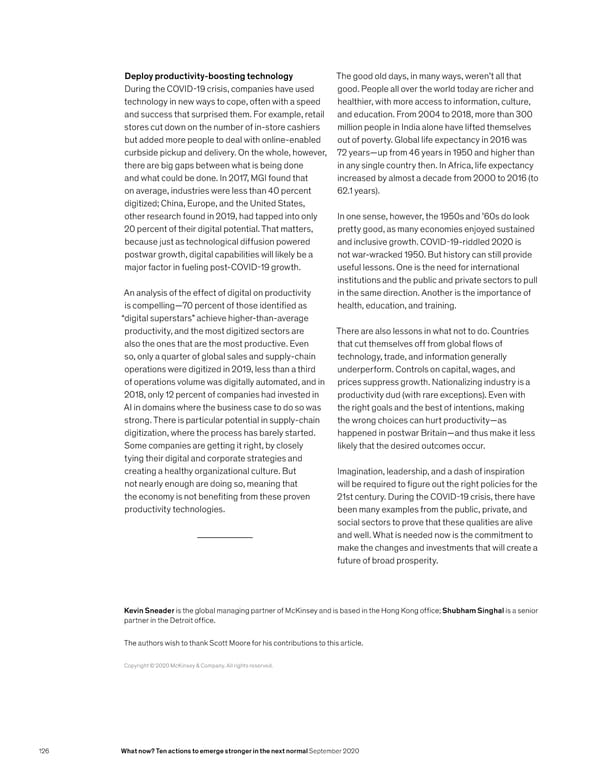Deploy productivity-boosting technology The good old days, in many ways, weren’t all that During the COVID-19 crisis, companies have used good. People all over the world today are richer and technology in new ways to cope, often with a speed healthier, with more access to information, culture, and success that surprised them. For example, retail and education. From 2004 to 2018, more than 300 stores cut down on the number of in-store cashiers million people in India alone have lifted themselves but added more people to deal with online-enabled out of poverty. Global life expectancy in 2016 was curbside pickup and delivery. On the whole, however, 72 years—up from 46 years in 1950 and higher than there are big gaps between what is being done in any single country then. In Africa, life expectancy and what could be done. In 2017, MGI found that increased by almost a decade from 2000 to 2016 (to on average, industries were less than 40 percent 62.1 years). digitized; China, Europe, and the United States, other research found in 2019, had tapped into only In one sense, however, the 1950s and ’60s do look 20 percent of their digital potential. That matters, pretty good, as many economies enjoyed sustained because just as technological diffusion powered and inclusive growth. COVID-19-riddled 2020 is postwar growth, digital capabilities will likely be a not war-wracked 1950. But history can still provide major factor in fueling post-COVID-19 growth. useful lessons. One is the need for international institutions and the public and private sectors to pull An analysis of the effect of digital on productivity in the same direction. Another is the importance of is compelling—70 percent of those identified as health, education, and training. “digital superstars” achieve higher-than-average productivity, and the most digitized sectors are There are also lessons in what not to do. Countries also the ones that are the most productive. Even that cut themselves off from global flows of so, only a quarter of global sales and supply-chain technology, trade, and information generally operations were digitized in 2019, less than a third underperform. Controls on capital, wages, and of operations volume was digitally automated, and in prices suppress growth. Nationalizing industry is a 2018, only 12 percent of companies had invested in productivity dud (with rare exceptions). Even with AI in domains where the business case to do so was the right goals and the best of intentions, making strong. There is particular potential in supply-chain the wrong choices can hurt productivity—as digitization, where the process has barely started. happened in postwar Britain—and thus make it less Some companies are getting it right, by closely likely that the desired outcomes occur. tying their digital and corporate strategies and creating a healthy organizational culture. But Imagination, leadership, and a dash of inspiration not nearly enough are doing so, meaning that will be required to figure out the right policies for the the economy is not benefiting from these proven 21st century. During the COVID-19 crisis, there have productivity technologies. been many examples from the public, private, and social sectors to prove that these qualities are alive and well. What is needed now is the commitment to make the changes and investments that will create a future of broad prosperity. Kevin Sneader is the global managing partner of McKinsey and is based in the Hong Kong office; Shubham Singhal is a senior partner in the Detroit office. The authors wish to thank Scott Moore for his contributions to this article. Copyright © 2020 McKinsey & Company. All rights reserved. 126 What now? Ten actions to emerge stronger in the next normal September 2020
 What Now? Page 127 Page 129
What Now? Page 127 Page 129